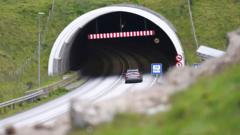The Shetland Islands could see a significant transformation similar to that of the Faroe Islands, thanks to potential new undersea tunnels aimed at bridging the gap between the isles and enhancing economic viability. According to Aksel Johannesen, the Faroese Prime Minister, such infrastructure investments have proven effective for local growth and community revitalization. This initiative to replace older ferry systems with tunnels could soon provide Shetland with a modern transport system, allowing better access to remote islands like Unst, home to the northernmost point in the UK.
The Shetland Islands Council has revealed that a multi-million pound project would primarily be funded through borrowing, with costs reimbursed via tolls. This could serve as a pioneering model for other Scottish islands struggling with similar transport challenges. Critics have pointed out the procrastination of Scottish politicians in pursuing tunnel schemes compared to the proactive approach of the Faroese, where 23 tunnels now connect their 18 islands.
Anne Anderson of Scottish Sea Farms, who highlights the diminishing global market share of Scottish salmon partly due to inadequate infrastructure, suggests that Scotland should adopt the Faroese methods. The tunnels have been credited with fostering both population growth and economic stability in the Faroe Islands, which has a comparable population of around 54,000, as opposed to Shetland’s 23,000.
Two significant examples include a 7.1-mile tunnel featuring the world's only underwater roundabout, showcasing the advanced engineering behind such projects. Andy Sloan from engineering firm COWI, which is advising on the Shetland project, stresses that adopting similar construction techniques utilized in the Faroe Islands could benefit Shetland significantly.
Prof. Erika Anne Hayfield from the University of the Faroe Islands mentioned the socioeconomic advantages their tunnels have provided, allowing island dwellers to easily access jobs while maintaining vibrant local communities. However, she also noted the ongoing debate regarding infrastructure investments versus essential public services like education and healthcare.
Although Shetland is situated closer to Norway and Denmark than to mainland Scotland, it possesses robust coastal and fishing industries, which advocate for investment in infrastructure to unlock further economic potential. Local leaders, like Emma Macdonald, emphasize the urgency of tunnel construction, expressing excitement about the opportunities that could follow.
Shetland's plan to construct tunnels to four islands has begun with a feasibility study estimations of approximately £990,000, yet detailed technology and funding assessments remain ongoing. The transition away from aging ferries—carrying about 750,000 passengers annually at a substantial cost—highlights an essential need for modernization. While tolls on tunnels may mirror previous infrastructure projects, local residents, according to responses, might welcome this shift in light of their current transportation struggles.
Concerns regarding the impact of tunnel construction on community identity remain, with views contrasting between the convenience it may offer against the potential alteration of island life. Yet, local business operators, like Pat Burns from Unst, see the tunnels as essential to combating logistical challenges in their operations.
The momentum for establishing tunnels in the Shetland Islands echoes the success seen in the Faroe Islands, propelling the archipelago closer to realizing a future defined by resourcefulness and connectivity.
The Shetland Islands Council has revealed that a multi-million pound project would primarily be funded through borrowing, with costs reimbursed via tolls. This could serve as a pioneering model for other Scottish islands struggling with similar transport challenges. Critics have pointed out the procrastination of Scottish politicians in pursuing tunnel schemes compared to the proactive approach of the Faroese, where 23 tunnels now connect their 18 islands.
Anne Anderson of Scottish Sea Farms, who highlights the diminishing global market share of Scottish salmon partly due to inadequate infrastructure, suggests that Scotland should adopt the Faroese methods. The tunnels have been credited with fostering both population growth and economic stability in the Faroe Islands, which has a comparable population of around 54,000, as opposed to Shetland’s 23,000.
Two significant examples include a 7.1-mile tunnel featuring the world's only underwater roundabout, showcasing the advanced engineering behind such projects. Andy Sloan from engineering firm COWI, which is advising on the Shetland project, stresses that adopting similar construction techniques utilized in the Faroe Islands could benefit Shetland significantly.
Prof. Erika Anne Hayfield from the University of the Faroe Islands mentioned the socioeconomic advantages their tunnels have provided, allowing island dwellers to easily access jobs while maintaining vibrant local communities. However, she also noted the ongoing debate regarding infrastructure investments versus essential public services like education and healthcare.
Although Shetland is situated closer to Norway and Denmark than to mainland Scotland, it possesses robust coastal and fishing industries, which advocate for investment in infrastructure to unlock further economic potential. Local leaders, like Emma Macdonald, emphasize the urgency of tunnel construction, expressing excitement about the opportunities that could follow.
Shetland's plan to construct tunnels to four islands has begun with a feasibility study estimations of approximately £990,000, yet detailed technology and funding assessments remain ongoing. The transition away from aging ferries—carrying about 750,000 passengers annually at a substantial cost—highlights an essential need for modernization. While tolls on tunnels may mirror previous infrastructure projects, local residents, according to responses, might welcome this shift in light of their current transportation struggles.
Concerns regarding the impact of tunnel construction on community identity remain, with views contrasting between the convenience it may offer against the potential alteration of island life. Yet, local business operators, like Pat Burns from Unst, see the tunnels as essential to combating logistical challenges in their operations.
The momentum for establishing tunnels in the Shetland Islands echoes the success seen in the Faroe Islands, propelling the archipelago closer to realizing a future defined by resourcefulness and connectivity.




















